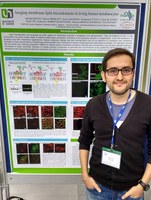Best poster prize for NARILIS post-doc researcher, Abdallah Mound, at the 13th Meeting of the E2BRN
The UNamur Cell & Tissue Laboratory is a member of the European Epidermal Barrier Research Network (E2BRN). E2BRN is a meeting point for scientists from European countries interested in a variety of aspects of epidermal barrier function. The aim of E2BRN is to provide a forum for exchange of knowledge, technology, ex vivo and in vivo epidermal barrier models, and other aspects of epidermal barrier research to facilitate collaborations and innovations.
In September 2015, Abdallah Mound participated to the 13th Meeting of the E2BRN in Rotterdam. During this conference, he presented the new tools that he developed to detect and visualize lipid microdomains in plasma membranes of keratinocytes. His data thereby allows to put an end to the controversies surrounding the existence of such membrane microdomains. With his poster entitled "Imaging membrane lipid microdomains in live human keratinocytes", he was awarded the Best Poster Prize!
ABSTRACT
Imaging membrane lipid microdomains in live human keratinocytes
A Mound,1 M Hermant,1 V Lozanova,1 D Tyteca,2 C Guere,3 K Vie,3 C Lambert de Rouvroit,1 F Chainiaux-Debacq1 and Y Poumay1
1 Narilis, University of Namur, Namur, Belgium, 2 De Duve Institute—Université catholique de Louvain, Brussels, Belgium and 3 Laboratoires Clarins, Paris, France
Lipid microdomains are proposed as small regions of membrane enriched in cholesterol and sphingomyelin. They are believed to form a lipid environment into which certain types of proteins preferentially (co)localize. Activation of cell signaling requires a re-organization, in the cell membrane, of receptors and their intracellular signalosome. Several evidences indicate that lipid microdomains may act as platforms to coordinate such complexes. Disruption of lipid microdomains in keratinocytes demonstrated their involvement in several physiological (differentiation, aging...) and pathological (cancer, atopic dermatitis…) processes, in cell junctions (desmosomes), as well as during apoptotic responses to UV. Our laboratory showed that cell stress with methyl-β-cyclodextrin (MβCD) to deplete plasma membrane cholesterol disrupts lipid microdomains and activates signaling pathways reminiscent of atopic dermatitis. Because of multiple potential involvement of perturbed lipid microdomains during epidermal pathologies and since their existence is still controverted we aimed at visualizing such lipid microdomains in keratinocytes. Vital imaging of living human keratinocytes was performed to characterize lipid microdomains location and distribution. Sphingomyelin (SM)-enriched lipid microdomains were visualized either by insertion of exogenous BODIPY-SM or by direct labeling of endogenous SM using non-toxic fragment of lysenin toxin fused to fluorescent mCherry protein. Similarly, cholesterol-enriched microdomains were labelled using fluorescently-labelled theta toxin. Through confocal microscopy of planar membranes and several Z-stack analysis, SM- and cholesterol-enriched lipid microdomains were actually identified. Their detection was impossible after incubation with MβCD, indicating that cholesterol organizes such domains, however EGF receptor was found to localize in these membrane areas.
 NAmur Research Institute for LIfe Sciences
NAmur Research Institute for LIfe Sciences


